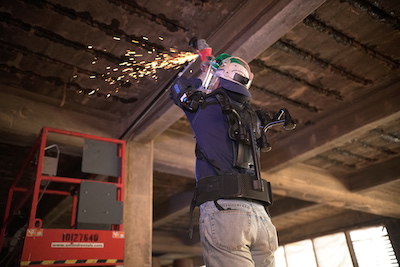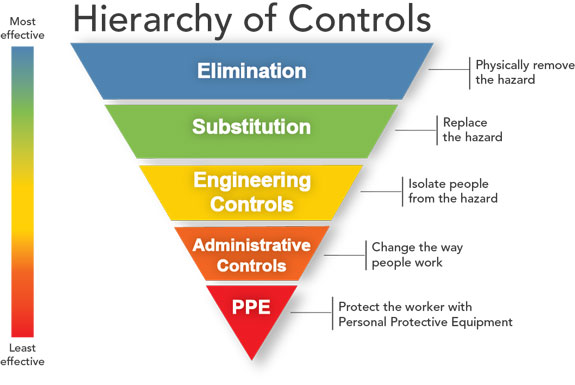
Wearable exoskeletons and ergonomics are getting a lot of attention lately. Exoskeletal devices have already shown great promise and success as rehabilitation and disability solutions, and at first glance, they appear to be a proverbial “silver bullet” in solving workplace ergonomics issues.
The appeal is obvious, but are wearable exoskeletons really an easy and effective workplace ergonomics improvement? The answer may surprise you.
What are Wearable Exoskeletons?
A wearable exoskeleton is a suit-like structure that’s intended to change the way a person exerts forces against other objects, or the way a person receives or experiences externally applied forces. For example, an exoskeleton may be viewed as:
- augmenting a person’s strength, making him or her able to exert more force than normal — “make her stronger”; or
- reducing the strength exertions required of the person to perform a specific task — “lighten the load”
How Do They Work?
There are two general types of exoskeletons:
- Powered (or Active) Exoskeletons — usually rigid structures with articulations using battery power to augment a worker’s strength; and
- Passive Exoskeletons — designed to lighten the load experienced by the worker’s body, or a specific body area, like the shoulder. These are often made of a mix of both rigid and softer material designed to move in conjunction with the worker.
Where Do Exoskeletons Fit in the Hierarchy of Ergonomics Controls?

NIOSH has not yet provided definitive guidance on this topic, citing the need for more study:
“As with any technologic innovation some of the pros and cons and barriers to adoption are not completely understood.” NIOSH
However, in practice, leading companies are already beginning to categorize them as a form of Personal Protective Equipment (PPE). Notably, professional ergonomists and safety experts recognize PPE as the least effective form of workplace hazard intervention — a last resort in hazard control. PPE also brings a host of regulatory requirements into play, further complicating their use in the workplace. For example, see OSHA’s guidance on Personal Protective Equipment.
Engineering, elimination or substitutions are more reliable means to control risk, because they address the root cause of the hazard, not just the symptoms. Learn more about the Hierarchy of Ergonomics Controls.
The Ergonomics of Exoskeletons – Things to Consider
If you’re considering exoskeletons as a potential ergonomics solution, be sure to consider these important details.
Exoskeleton Fit, Function and Wearability
There are two types of “fit” when considering the ergonomics of exoskeletons:
- Is a wearable exoskeleton the right “fit” as a solution?
- Does it “fit” the person wearing it well?
In other words, does this form of PPE solve a specific ergonomics issue in a specific task? If so, is it properly fitted to maximize effectiveness and comfort for each individual that will wear one while performing that specific task?
Exoskeletons are not something a worker might wear all day, everyday, unless that worker is engaged in a very specific task at all times. Today’s exoskeletons are not cross-task devices, meaning it’s unlikely you would wear the same device while lifting boxes, for example, as you would to lighten the load from overhead work.
Matching an exoskeleton to a specific person, and a specific task, is critical to success, or failure, as the case may be.
Personal/individual fit is extremely important when it comes to wearable exoskeletons, because a poorly fitted device may increase injury risk, sometimes substantially.
Remember, unless the exoskeleton device reliably deflects/transmits forces to the ground, any augmented force, or any passively redistributed force, is still being applied to the body somehow, somewhere. So, for example, if a device reduces the arm effort a worker needs to work overhead, those forces may be distributed to the body in some other way (generally through the straps or whatever means with which the device is secured to the body).
Care must be taken to ensure that redistributing those forces to other body regions and joints will not cause new ergonomics and safety concerns.
Exoskeleton Hygiene, Training, Maintenance and Storage
Exoskeletons are not easily shared, because to function properly, they need to be well fitted to a specific individual. Since these are wearable devices, hygiene is also a concern.
Therefore, if exoskeletons are chosen as a PPE, each individual worker should have his or her own, and steps should be taken to ensure proper hygiene and function for the long-term.
PPE also requires training, maintenance and secure storage to ensure effectiveness.
Things to Consider Before Implementing Wearable Exoskeletons
- Have you performed an assessment to identify and quantify a specific hazard, such as overhead work, then matched a specific exoskeleton to reliably address it?
- Would an engineering, substitution or elimination control be a more reliable way to control the root cause of this hazard?
- What time and resources will be required to purchase, individually fit, train, clean, maintain and store exoskeleton devices in the normal course of production?
- Is the time it takes to locate, don, doff and store the exoskeleton PPE before and after performing the specific task acceptable?
- Is the device suitable for the environment of use, in terms of temperature, breathability, hygiene and wearing comfort?
- Will workers accept a wearable device for everyday use? What are the consequences if employees do not accept, are not able, or do not consistently adhere to exoskeleton usage protocols?
- Has the exoskeleton been thoroughly tested in the actual task, working conditions and operating environment?
Conclusion
So, are wearable exoskeletons an effective workplace ergonomics improvement? The answer is entirely in the details of how and why an exoskeleton is identified as a solution to a specific problem, and then, in how that new PPE is implemented and maintained.
Exoskeletons hold promise as workplace ergonomics interventions, but today, they are not a “silver bullet’ solution, even with positive field reports of reduced localized muscle loading and fatigue.
The jury is still out as to whether they are effective at reducing injury rates over the long term. If you’re considering one, Ergoweb advises you thoroughly test it in actual production conditions to learn whether: (1) it adequately reduces a specific hazard; (2) it can be implemented as a reliable control in real day-to-day production; (3) the device does not introduce new or unintended ergonomics, safety or production concerns; and (4) to establish and document PPE protocols for training, use, storage and maintenance, if it will be deployed.
Jan 30, 2020 UPDATE:
Thanks to readers Maury Nussbaum, PhD, CPE and Kimberly Monroe, PhD, CPE for suggesting these additional evidence based resources for those interested in exoskeletons in the workplace.
- A trove of new research has been released through the journal IISE Transactions on Occupational Ergonomics and Human Factors as a special issue on Occupational Exoskeletons. It will reportedly be available for free download for some period of time beginning roughly Feb 1, 2020.
- NIOSH blog on exoskeletons
- 11 December 2019 article from NIOSH on exoskeletons
- Compilation of existing exoskeletons: exoskeletonreport.com
- ASTM International Committee F48 on Exoskeletons and Exosuits
Image Credit: Ekso Bionics, eksobionics.com
